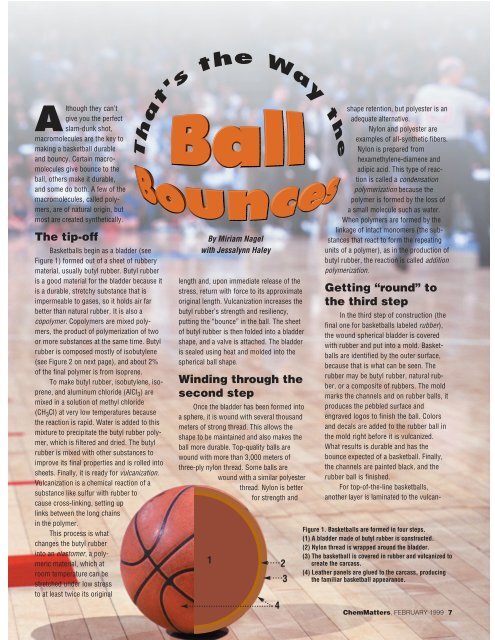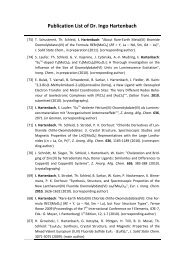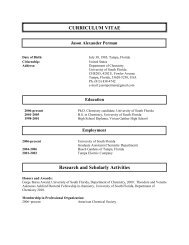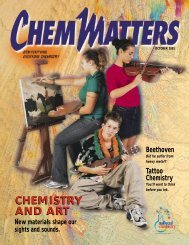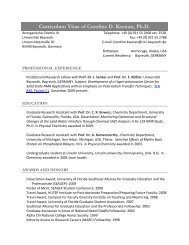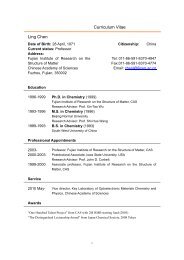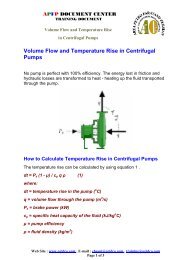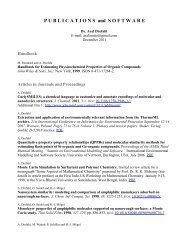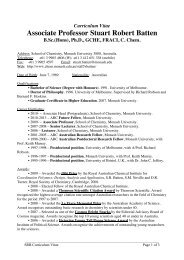Sports Drinks: Don't Sweat the Small Stuff - American Chemical ...
Sports Drinks: Don't Sweat the Small Stuff - American Chemical ...
Sports Drinks: Don't Sweat the Small Stuff - American Chemical ...
You also want an ePaper? Increase the reach of your titles
YUMPU automatically turns print PDFs into web optimized ePapers that Google loves.
Although <strong>the</strong>y can’t<br />
give you <strong>the</strong> perfect<br />
slam-dunk shot,<br />
macromolecules are <strong>the</strong> key to<br />
making a basketball durable<br />
and bouncy. Certain macromolecules<br />
give bounce to <strong>the</strong><br />
ball, o<strong>the</strong>rs make it durable,<br />
and some do both. A few of <strong>the</strong><br />
macromolecules, called polymers,<br />
are of natural origin, but<br />
most are created syn<strong>the</strong>tically.<br />
The tip-off<br />
Basketballs begin as a bladder (see<br />
Figure 1) formed out of a sheet of rubbery<br />
material, usually butyl rubber. Butyl rubber<br />
is a good material for <strong>the</strong> bladder because it<br />
is a durable, stretchy substance that is<br />
impermeable to gases, so it holds air far<br />
better than natural rubber. It is also a<br />
copolymer. Copolymers are mixed polymers,<br />
<strong>the</strong> product of polymerization of two<br />
or more substances at <strong>the</strong> same time. Butyl<br />
rubber is composed mostly of isobutylene<br />
(see Figure 2 on next page), and about 2%<br />
of <strong>the</strong> final polymer is from isoprene.<br />
To make butyl rubber, isobutylene, isoprene,<br />
and aluminum chloride (AlCl 3) are<br />
mixed in a solution of methyl chloride<br />
(CH 3Cl) at very low temperatures because<br />
<strong>the</strong> reaction is rapid. Water is added to this<br />
mixture to precipitate <strong>the</strong> butyl rubber polymer,<br />
which is filtered and dried. The butyl<br />
rubber is mixed with o<strong>the</strong>r substances to<br />
improve its final properties and is rolled into<br />
sheets. Finally, it is ready for vulcanization.<br />
Vulcanization is a chemical reaction of a<br />
substance like sulfur with rubber to<br />
cause cross-linking, setting up<br />
links between <strong>the</strong> long chains<br />
in <strong>the</strong> polymer.<br />
This process is what<br />
changes <strong>the</strong> butyl rubber<br />
into an elastomer, a polymeric<br />
material, which at<br />
room temperature can be<br />
stretched under low stress<br />
to at least twice its original<br />
By Miriam Nagel<br />
with Jessalynn Haley<br />
length and, upon immediate release of <strong>the</strong><br />
stress, return with force to its approximate<br />
original length. Vulcanization increases <strong>the</strong><br />
butyl rubber’s strength and resiliency,<br />
putting <strong>the</strong> “bounce” in <strong>the</strong> ball. The sheet<br />
of butyl rubber is <strong>the</strong>n folded into a bladder<br />
shape, and a valve is attached. The bladder<br />
is sealed using heat and molded into <strong>the</strong><br />
spherical ball shape.<br />
Winding through <strong>the</strong><br />
second step<br />
Once <strong>the</strong> bladder has been formed into<br />
a sphere, it is wound with several thousand<br />
meters of strong thread. This allows <strong>the</strong><br />
shape to be maintained and also makes <strong>the</strong><br />
ball more durable. Top-quality balls are<br />
wound with more than 3,000 meters of<br />
three-ply nylon thread. Some balls are<br />
wound with a similar polyester<br />
thread. Nylon is better<br />
for strength and<br />
1<br />
4<br />
2<br />
3<br />
shape retention, but polyester is an<br />
adequate alternative.<br />
Nylon and polyester are<br />
examples of all-syn<strong>the</strong>tic fibers.<br />
Nylon is prepared from<br />
hexamethylene-diamene and<br />
adipic acid. This type of reaction<br />
is called a condensation<br />
polymerization because <strong>the</strong><br />
polymer is formed by <strong>the</strong> loss of<br />
a small molecule such as water.<br />
When polymers are formed by <strong>the</strong><br />
linkage of intact monomers (<strong>the</strong> substances<br />
that react to form <strong>the</strong> repeating<br />
units of a polymer), as in <strong>the</strong> production of<br />
butyl rubber, <strong>the</strong> reaction is called addition<br />
polymerization.<br />
Getting “round” to<br />
<strong>the</strong> third step<br />
In <strong>the</strong> third step of construction (<strong>the</strong><br />
final one for basketballs labeled rubber),<br />
<strong>the</strong> wound spherical bladder is covered<br />
with rubber and put into a mold. Basketballs<br />
are identified by <strong>the</strong> outer surface,<br />
because that is what can be seen. The<br />
rubber may be butyl rubber, natural rubber,<br />
or a composite of rubbers. The mold<br />
marks <strong>the</strong> channels and on rubber balls, it<br />
produces <strong>the</strong> pebbled surface and<br />
engraved logos to finish <strong>the</strong> ball. Colors<br />
and decals are added to <strong>the</strong> rubber ball in<br />
<strong>the</strong> mold right before it is vulcanized.<br />
What results is durable and has <strong>the</strong><br />
bounce expected of a basketball. Finally,<br />
<strong>the</strong> channels are painted black, and <strong>the</strong><br />
rubber ball is finished.<br />
For top-of-<strong>the</strong>-line basketballs,<br />
ano<strong>the</strong>r layer is laminated to <strong>the</strong> vulcan-<br />
Figure 1. Basketballs are formed in four steps.<br />
(1) A bladder made of butyl rubber is constructed.<br />
(2) Nylon thread is wrapped around <strong>the</strong> bladder.<br />
(3) The basketball is covered in rubber and vulcanized to<br />
create <strong>the</strong> carcass.<br />
(4) Lea<strong>the</strong>r panels are glued to <strong>the</strong> carcass, producing<br />
<strong>the</strong> familiar basketball appearance.<br />
ChemMatters, FEBRUARY 1999 7


